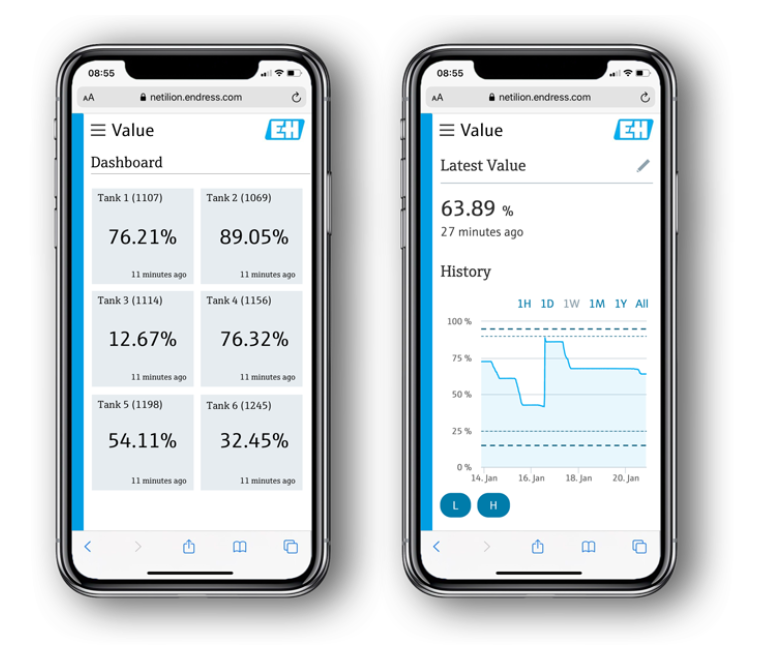6 examples of Industrial IoT monitoring solutions – fresh insights to get you digital!
Everyone wants cheaper, smarter, and more efficient monitoring systems. IIoT monitoring services can give you secure access to your process values anytime and anywhere.
Hey, it’s great to see you here again! Today, I have more tips to help you finally go digital, but first, let me recap last week.
We discussed native Industrial IoT devices already on the market. You’ll find this type of cloud-based device becoming more popular in automation, so you need to keep yourself up to date. Here’s the link to that article: Industrial IoT radar level sensors in intermediate bulk containers (mobile plastic tanks).
So maybe you’re asking yourself if you really need to replace all your instrumentation to finally get Industrial IoT. You’re right, you don’t have to, and today I’ll share some opportunities to start an IoT application.
IIoT services can apply to multiple scenarios, from health monitoring to smart documentation management. And now you can monitor process values anywhere with IoT-ready products and even non-IoT-ready products using a trick or two.
Today, let’s see how IIoT monitoring services can make your applications more efficient than ever. Stick around and let’s learn!
Monitoring provides great opportunities for trying out IIoT
In fact, monitoring applications are usually the best way to try out all kinds of new things. I found that out back when I used to take care of wireless products in processes all the time.
When you have a new technology, you need to test its reliability in real applications and different segments before making it a standard option. To do that, many companies create pilot projects to learn more about the technology before adopting it on a larger scale.
Monitoring applications offer less risk than control applications, so they’re a great place to start.

Of course, nobody wants unstable monitoring solutions, but everybody likes improvements, so customers like to test the technology repeatedly in small segments. A new solution has to experience enough variables and wear before it can become a common option on the market.
So monitoring applications can be a fast way to try out IIoT services, such as the Netilion Value, where you can access your primary value (PV) from your field devices, not to mention enjoy a bunch of other features. It makes your monitoring application more effective than other standard solutions on the market.
Level monitoring made simple
I remember one solution I applied to a process in a chemical plant. The operators needed a simple and safe way to monitor their levels of sulfuric acid. They wanted to see the value from a good distance away so they could stop risking acid burns from checking the level manually.
We used radar level sensors with WirelessHART communication that had a local display for the operators. A SCADA system would’ve cost too much, so the customer chose to view the values on the WirelessHART Fieldgate’s web browser.
Today, with the advancement of IIoT, the same customer could afford to set up the monitoring system and collect all its data anywhere using a phone, tablet, or laptop.
Apart from the cost, IIoT monitoring services like Netilion Value offers secure communication with the cloud and access to many features like archives and device maps.
Level monitoring with WirelessHART or HART gateways are easy steps to begin your Industrial IoT monitoring system.
Temperature monitoring
Like level monitoring, temperature measurement provides many opportunities to sample IoT monitoring services. Many applications in various industries need temperature sensors across the plant.
I once faced a real challenge in a metal company where high heat consistently damaged device cables. WirelessHART fixed that problem, but the operators could see the values in the control room only.

Today, IIoT improves these sorts of applications by offering other means of access to the process values. You can also receive notifications, check trends, and review other relevant information regarding your temperature monitoring solution.
While the data still goes to the SCADA system, you can also access it remotely using your phone or tablet.
Water quality monitoring
In a food and beverage plant, you have many points where you must check water quality. Using wireless communication between devices and integrating all the data into the cloud makes it easy to check all of them in one go.
If a measuring point is far away or has little structure, then a smart system solution can help a lot. Even at the plant, where it’s easy to collect data, wireless or HART communication connected to an edge device can give you straightforward access to the process value.
So water quality is yet another excellent opportunity to start IoT in your plant and understand its fast implementation, simple interface, and overall efficiency. And of course, you can pull whatever information you need from the traditional SCADA or remotely.
Pressure monitoring
Along with temperature, pressure is one of the most common measuring principles across several industries. Some pressure devices, most of them mechanical, do nothing more than measure pressure locally, so they’re not even part of a control loop.
In mining industries, WirelessHART communication has become popular for monitoring pressure points across plants, and some of these plants are vast. In my experience with such projects, the distance makes it a challenge to check this data.
Using the WirelessHART, it’s super simple to send information to an edge device that pushes it to a secure cloud environment. That means that anywhere in a big mining plant, you can access pressure values and their history, plus receive notifications if they reach min or max values.
Flow monitoring
I almost always enjoyed flow monitoring systems. One of my cases involved a food company where the operators wanted to monitor the natural gas provided by another company.
We provided a Coriolis flow meter with a solar panel system, because the flow meter’s structure lacked the energy needed. We then connected to it using WirelessHART, sending all the data to a data collector.
However, when the operators wanted to see the gas flow sent by the mass flow meter, they needed to go to the data collector to verify it. Today, a more straightforward way to get this information would be to collect this data in an IIoT cloud and display it in a secure web environment.
HART devices provide up to four values, so you need to check how many you can have in the cloud and configure it appropriately, depending on your requirements.
The IIoT monitoring service in this case gave more access flexibility for the process value as well as min/max notifications in the cloud and measurement history.
IIoT is easy
You have monitoring systems throughout all industries. With IIoT devices like WirelessHART communication and HART gateways, you can integrate your process value into the cloud and have it anywhere at any time.
Furthermore, you can split this information with another system and have the best of both worlds. Simple access and redundancy, right at your fingertips. What more could you want?
If you liked this article, please share it on your social media using the #Netilion tag.
Have a good one, and see you next week!



